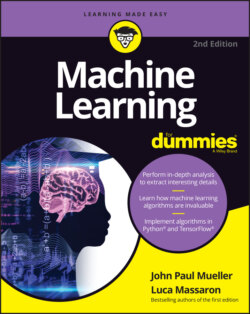Читать книгу Machine Learning For Dummies - John Paul Mueller, John Mueller Paul, Luca Massaron - Страница 60
Repairing machines
ОглавлениеMost of this chapter discusses current technology, where the technology will go in the future, and why things work as they do. However, notice that the discussion always focuses on the technology doing something. That’s right, before the technology can do anything else, it must perform a practical task that will attract attention and benefit humans in a manner that makes people want to have the technology for their own. It doesn’t matter what the technology is. Eventually, the technology will break. Getting the technology to do something useful is the prime consideration now, and the culmination of any dreams of what the technology will eventually do stretches years into the future, so mundane things like repairing the technology will still fall on human shoulders. Even if the human isn’t directly involved with the physical repair, human intelligence will direct the repair operation.
Some articles that you read online might make you believe that self-repairing robots are already a reality. For example, the International Space Station robots, Dextre and Canadarm, performed a repair of a faulty camera (see the story at https://space.io9.com/a-self-repairing-space-robot-on-the-international-space-1580869685). What the stories don’t say is that a human decided how to perform the task and directed the robots to do the physical labor. Self-repair is becoming achievable. The articles at https://spectrum.ieee.org/automaton/robotics/robotics-hardware/japanese-researchers-teaching-robots-to-repair-themselves and https://www.robotics.org/blog-article.cfm/How-Self-Healing-Robots-Repair-Themselves/219 describe how far the technology has come.
